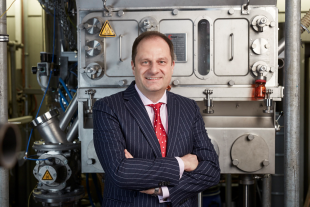Prof. Dr.-Ing. habil. Dr. h.c. Stefan Heinrich studied Process Engineering at the University of Magdeburg and received his Diploma in 1996 and his Ph.D. at the same university in 2000 in the field of fluidized bed spray granulation. From 2000 to 2002, he was Assistant Professor and from 2002 to 2008 Junior Professor at the University of Magdeburg, where he also received the Habilitation and the “venia legendi” in particle technology in 2006. In 2008 he became full professor and director of the Institute of Solids Process Engineering and Particle Technology of the Hamburg University of Technology, Germany. Also in 2008 he denied a call for a full professorship for Particle and Materials Treatment Technology at the TU Bergakademie Freiberg, Germany. From 2011-2012 he was also the Dean of the Department of Process and Chemical Engineering of the Hamburg University of Technology. In 2015 Stefan became a Honorary Doctor of the DonNTU (National University of the Ukraine).
He is an executive board member of the German Working Party on Drying and chairman of the executive board of the German Working Party on Agglomeration and Bulk Solid Materials of VDI-ProcessNet. He is also chairman of the Working Party on Agglomeration and member of the Working Party on Mechanics of Particulate Solids of the EFCE. Stefan is also the Coordinator of the German Research Foundation (DFG) Priority programme 1679 „Dynamic simulation of interconnected solids processes, Vice-Spokesperson of the DFG Research Training Group 2462 „Processes in natural and technical particle-fluid-systems” and a member of the DFG Collaborative Research Centre 986 „Tailor-made multiscale materials systems“, member of the „Center of Advanced Materials (ZHM)“, Hamburg, member of the Scientific Advisory Board of the Helmholtz Institute Freiberg for Resources Technology, Freiberg, Germany and a member of the Scientific Advisory Board of the Research Center Pharmaceutical Engineering (RCPE) of the TU Graz, Austria. He works also as Executive Editor of the journal „Advanced Powder Technology“ and as Thematic Editor of the journal „Particuology“. Stefan was also the chairman of the 2nd Nordic Baltic Drying Conference (NBDC 2017), Hamburg, Germany, June 2017 and he is the chairman of the Partec 2019 - International Congress on Particle Technology, Nürnberg, Germany, April 2019.
His main research interests are fluidized bed technology, particle formulation with granulation, coating and agglomeration, drying of solids, development of particular composite materials, particle based simulation methods (discrete element modelling, population balance modelling) and coupling with continuum approaches (CFD), contact and breakage mechanics of particles as well as steady-state and dynamic flowsheet simulation of solids processes. For his research activities in fluidized bed spray granulation Stefan received the DECHEMA-Prize 2015 of the Max Buchner Research Foundation and numerous other research awards.


